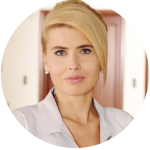[et_pb_section bb_built=”1″][et_pb_row][et_pb_column type=”4_4″][et_pb_text]
We can supplement deficiencies using removable or permanent prosthetic restorations (e.g. porcelain bridges). The latter, however, require grinding of adjacent, often healthy teeth. If we want to avoid this, then the best solution is implantological treatment (implant placement). It is worth knowing that today’s modern form of implantology treatment began in 1965. It was 47 years ago when Professor Ingvar Branemark discovered the phenomenon of osseointegration, which gave rise to the use of implants in dentistry. The phenomenon of this occurrence consists in a permanent connection between the implant surface and the patient’s bone, which allows the doctor to reconstruct the missing tooth roots and then allows the prosthetic restoration of the crowns on them. Implants are in no way inferior to their own teeth – apart from supplementing the deficiencies and thus better health, they also provide very good aesthetic values, increase self-esteem and, as a result, allow us to maintain a better mood. At the same time, if we care about it properly, they are a real investment for many years. Implantology treatment brings another myth: it is often thought to be long-term and targeted only at a narrow group of patients. It is not! In almost every case, dental implants can be considered as a solution, even if the patient has difficult anatomical conditions. We can significantly improve them by performing, e.g., controlled bone regeneration or maxillary sinus lift procedures. Of course, it is important to consider general and local contraindications. The latter are, for example, cure any infections in the mouth, cure tooth decay and periodontosis. It should be remembered that it is not the patient’s age, past diseases of the teeth or their surrounding tissues that are a contraindication to implantological treatment – on the contrary! Implants are currently made, among others, due to the loss of teeth as a result of their diseases (caries, complications of root canal treatment) or injuries. Duration of treatment is an individual matter, but current techniques allow to shorten it as much as possible – from several months to even one day (in favorable conditions). Treatment planning based on accurate clinical examination of the patient and modern radiological imaging diagnostics is important here. Professionally performed examination combined with the experience of a doctor and patient’s cooperation are a condition for a satisfactory result – new, extremely close to the nature of “third teeth”.
[/et_pb_text][et_pb_divider _builder_version=”3.0.91″ /][/et_pb_column][/et_pb_row][/et_pb_section]
Mieszkam i pracuję w Warszawie. Praktykę lekarską prowadzę od ponad dwudziestu lat. Jestem współwłaścicielką kliniki stomatologicznej Trio-Dent, gdzie leczę pacjentów, prowadzę badania naukowe, ale też udzielam pomocy osobom, które jej potrzebują.


